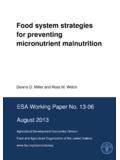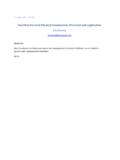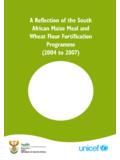Transcription of Indicators and Methods for Cross-Sectional Surveys of ...
1 Forward Vitamin and mineral deficiencies remain a significant public health problem in many parts of the world, particularly in developing countries where deficiencies to vitamin A, iron, iodine and other micronutrients leads to adverse health consequences. These include diminished learning and development capacity of young children and reduced work capacity of adults, both of which contribute to poor socioeconomic condition of populations. The implementation of effective intervention programs to eliminate or reduce the prevalence of vitamin and mineral deficiencies in populations requires a wide array of activities directed towards ensuring high coverage of interventions. One component of national micronutrient programs includes the periodic assessment of the status of vitamin and mineral deficiencies , as well as the adequacy of the coverage of interventions in a population using Cross-Sectional Surveys .
2 Periodic Cross-Sectional Surveys are helpful in answering questions such as: What is the current magnitude and distribution of selected vitamin and mineral deficiencies ? Has the prevalence of disease changed over time in comparison with previous Surveys ? What is the coverage of interventions, such as the proportion of target populations who have received nutrient supplements or are consuming fortified foods? Has coverage changed over time? Are there groups in the population where the prevalence of vitamin and mineral nutrient deficiencies remains high or where the coverage of interventions is inadequate? Results from Surveys also provide information on whether intervention strategies are helping to achieve program objectives. For example, if there are interventions directed to the population to promote behavioral change to overcome vitamin and mineral deficiencies , then the level of knowledge, attitudes, and practices (KAP) of the population can be assessed using periodic Surveys .
3 The results of a Cross-Sectional survey provide a snapshot of the vitamin and mineral status of a population at a specific time period. We hope you find this manual useful in the planning and implementation of Cross-Sectional Surveys and trust that the information generated from such Surveys will help to support programs to prevent and control vitamin and mineral deficiencies . Acknowledgements These guidelines have been developed by the Micronutrient Initiative and the Centers for Disease Control and Prevention in response to increasing interest by countries to undertake population-based assessment of vitamin and mineral deficiencies and the coverage of intervention programs. We would like to thank the many individuals who made comments on various versions of this manuscript with expertise in different aspects of nutrient status assessment and survey Methods : Shawn Baker, Erick Boy, Jenny Cervinskas, Christine Clewes, Denise Coitinho, Bruno de Benoist, Wilma Freire, Deborah Galuska, Heather Gardner, Larry Grummer-Strawn, Elaine Gunter, Maria Elena Jefferds, Jim Lepkowski, Julia Moorman, and Tom Schaetzel.
4 Individuals from the Program for Technology in Health (PATH) provided comments in the latter stages of manuals development, particularly in the area of rapid diagnostic tools and the appropriate use of tools in the field assessment of micronutrient status. Parts of this manual are based on the Urinary Iodine Assessment: A Manual on Survey and Laboratory Methods (Sullivan et al., 2000), the End-Decade Multiple Indicator Survey Manual: Monitoring Progress Toward the Goals of the 1990 World Summit for Children (UNICEF, 2000), the Multiple Indicator Cluster Survey Manual 2005 (UNICEF, 2006), and from documents and presentations developed by CDC. Two of the four authors, Jonathan Gorstein and Kevin Sullivan, performed this work, in part, as consultants to the Micronutrient Initiative. Jonathan Gorstein (University of Washington), Kevin Sullivan (Emory University and the Centers For Disease Control and Prevention), Ibrahim Parvanta (Centers for Disease Control and Prevention), and France Begin (Micronutrient Initiative).
5 Jonathan Gorstein Kevin M. Sullivan Department of Health Services Department of Epidemiology University of Washington Rollins School of Public Health School of Public Health Emory University 1959 NE Pacific Street, H-688 1518 Clifton Road, NE. Box No. 357660 Atlanta, GA 30322. Seattle, WA 98195 USA. USA. Ibrahim Parvanta France Begin Centers for Disease Control and Prevention Micronutrient Initiative International Micronutrient Malnutrition Box 56127. Prevention and Control Program (IMMPaCt) 250 Albert Street 4770 Buford Hwy., NE, MS K25 Ottawa, Ontario Atlanta, GA 30333 Canada USA. Suggested citation: Gorstein J, Sullivan KM, Parvanta I, Begin F. Indicators and Methods for Cross-Sectional Surveys of Vitamin and Mineral Status of Populations. The Micronutrient Initiative (Ottawa) and the Centers for Disease Control and Prevention (Atlanta), May 2007.
6 Indicators and Methods for Cross-Sectional Surveys of Vitamin and Mineral Status of Populations 1. Disclaimer The mention of product names and websites in this document do not constitute an official endorsement for the products by any of the agencies or individuals involved in the development of this manual. They are mentioned to provide users of this manual with information on the types of products frequently used in micronutrient Surveys and where to obtain further information. None of the authors, reviewers, or agencies has a monetary link to the private companies mentioned. Indicators and Methods for Cross-Sectional Surveys of Vitamin and Mineral Status of Populations 2. Abbreviations AGP Alpha 1-acid glycoprotein APP Acute Phase Proteins ARI Acute Respiratory Infection CDC Centers for Disease Control and Prevention, Atlanta, USA. CRP C-Reactive Protein d Level of absolute precision DBS Dried blood spot DEFF Design Effect DHS Demographic and Health Survey EDTA Ethylenediaminetetraacetic acid EPI Expanded Programme on Immunization Hb Hemoglobin HH Household HKI Helen Keller International HPLC High-Pressure Liquid Chromatography ICCIDD International Council for the Control of Iodine Deficiency Disorders ID Iron Deficiency IDA Iron Deficiency Anemia IDD Iodine Deficiency Disorders ILSI International Life Science Institute IMMPaCt International Micronutrient Malnutrition Prevention and Control Program, CDC.
7 INACG International Nutritional Anemia Consultative Group IVACG International Vitamin A Consultative Group KAP Knowledge, Attitudes, and Practices MAPit Micronutrient Action Plan instructional tool MICS Multiple Indicator Cluster Survey MI Micronutrient Initiative MM Micronutrient Malnutrition PATH Program for Technology in Health PDAs Personal Digital Assistants ppm Parts Per Million PPS Probability Proportionate to Size PSU Primary Sampling Unit RBP Retinol Binding Protein SF Serum Ferritin TfR Transferrin Receptor TSH Thyroid Stimulating Hormone (or thyrotropin). UI Urinary iodine UNICEF United Nations Children's Fund USI Universal Salt Iodization VAD Vitamin A Deficiency WHO World Health Organization WRA Women of Reproductive Age WSC World Summit for Children Z Z-score Indicators and Methods for Cross-Sectional Surveys of Vitamin and Mineral Status of Populations 3.
8 Indicators and Methods for Cross-Sectional Surveys of Vitamin and Mineral Status of Populations 4. Table of Contents Forward .. ii iii 2. 3. Table of Contents .. 5. Chapter 1 Overview .. 11. Introduction .. 11. Public Health Significance of Vitamin and Mineral 11. Assessing Multiple Vitamin and Mineral deficiencies .. 12. Planning the Survey .. 12. Chapter 2 Overall Survey 15. Which Nutrients to Include?.. 15. Which Indicators to Measure?.. 15. General Issues Related to Indicator Which Target Groups to Assess?.. 20. Preschool children ..21. School age children ..21. Women of reproductive age ..22. Summary on target groups and survey sites .. 23. Where to measure participants - household or a central site?.. 23. Benefits of survey to participants .. 24. Chapter 3 Survey Design and Sampling Strategies .. 25. Introduction .. 25. National vs. Sub-National 26.
9 Indicators and Methods for Cross-Sectional Surveys of Vitamin and Mineral Status of Populations 5. Household vs. clinic vs. school-based Surveys .. 26. Independent Survey vs. Incorporating Micronutrient Indicators into another Survey .. 27. Sample Size Calculations .. 28. Sample size for proportion in single Cross-Sectional survey ..29. Sample size calculation for comparing two Surveys ..31. Subgroup Comparisons and their affect on sample Accounting for Response Rates ..35. Number of Households ..36. Number of clusters and samples per cluster .. 37. Number of Households/Individuals per Cluster and the Number of Clusters ..37. How to select clusters .. 39. PPS selection of clusters ..39. Random and systematic selection of Summary .. 43. Chapter 4 Household and Subject 45. Segmenting clusters .. 46. How to Map a Cluster/Segment When Accurate Maps Are Not Available.
10 49. More Detailed Map of Area Selected and Selecting Households Random or Systematic Selection of a Fixed Number of Households Method ..51. Selecting Households using Random or Systematic Selection of a Fixed Number of 53. Random or systematic selection of a fixed number of households ..53. Random selection of first household .. 55. Selecting the First Selecting Subsequent Households ..55. Some general notes on the household selection 56. Selection of eligible individuals within households .. 57. Chapter 5 Survey Planning, Organization, Training, and Field Work .. 59. 59. Coordination and Communications .. 59. Indicators and Methods for Cross-Sectional Surveys of Vitamin and Mineral Status of Populations 6. Protocol .. 60. Recruitment of Survey Teams .. 60. Pilot 62. Training team 62. Development of Survey Instruments and 62. Other survey forms and documents.















